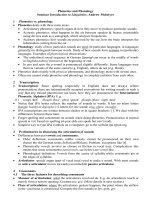Phonetics and phonology assignment 1
Bạn đang xem bản rút gọn của tài liệu. Xem và tải ngay bản đầy đủ của tài liệu tại đây (84.44 KB, 5 trang )
PART 1
1. Human speech organs
In the spaces provided, fill in the names of the human speech organs numbered in
the diagram.
1. upper lip
8. lower lip
2. upper teeth
9. tip
3. alveolar ridge
10. blade
4. hard palate
11. front
5. velum
12. back
6. uvula
13. oral cavity
7. epiglottis
14. vocal folds
2. Phonemic representation
Work out phonemic representations for the following words, using the convention of
slash brackets. Remember that phonemic representations adhere strictly to the
principle: `one sound, one symbol'. Pronounce some of these words to yourself and
attempt to write down their phonetic transcriptions next to the phonemic
transcriptions.
Word
cat
pyjamas
cast
fission
cod
through
kill
cattle
shut
quite
floor
there
calm
heard
gang
Phonemic
transcription
/kæt/
/pɪˈdʒɑː.məz/
/kɑːst/
/ˈfɪʃ.ən/
/kɒd/
/θruː/
/kɪl/
/ˈkæt.əl/
/ʃʌt/
/kwaɪt/
/flɔːr/
/ðeər/
/kɑːm/
/hɪər/
/ɡæŋ/
Phonetic
transcription
[kæt]
[pɪˈdʒɑː.məz]
[kɑːst]
[ˈfɪʃ.ən]
[kɒd]
[θruː]
[kɪl]
[ˈkæt.əl]
[ʃʌt]
[kwaɪt]
[flɔːr]
[ðeər]
[kɑːm]
[hɪər]
[ɡæŋ]
3. Airstream Mechanism
Fill in the blanks in the following passage with the words provided (some words may
be used more than once):
voiced clicks ejectives velaric voiceless glottalic pulmonic plosives
implosives
There are three principle airstream mechanisms: the pulmonic airstream mechanism,
the velaric airstream mechanism, and the glottalic airstream mechanism. In normal
utterances in all the languages of the world, the airstream is always flowing outward
if the pulmonic ejective airstream mechanism is involved. Stops made with this
mechanism are called plosives. The only mechanism that is used in some languages
to produce some sounds with inward going air and some sounds with outward
going air is the glottalic airstream mechanism. Stops made with this mechanism
acting ingressively are called implosives. Stops made with this mechanism acting
egressively are called ejectives. The mechanism that is used in language to produce
sounds only with inward going air is the velaric airstream mechanism. Stops made
with this mechanism are called clicks. Stops may vary in their voice onset time. In
this respect, [b,d,g] are voiced stops, [p,t,k] are voiceless stops.
PART 2
Underline the correct answer.
1/Which of the following is the least common type of airstream mechanism used in human
speech production?
a) Pulmonic b) Egressive c) Ingressive d) Glottalic
2/Which airstream mechanism is used to produce ejective consonants?
a) Pulmonic b) Glottalic c) Velaric d) Both b) and c)
3/Which airstream mechanism is used to produce click consonants?
a) Pulmonic b) Glottalic c) Velaric d) Both b) and c)
4/Which of the following is a language that uses ejective consonants?
a) French b) English c) Hausa d) Spanish
5/Which of the following is NOT an example of a sound produced by a pulmonic airstream
mechanism?
a) /k/ in "kite" b) /p/ in "pat" c) /h/ in "hat" d) /f/ in "flee"
6/What is the most common type of airstream mechanism used in human speech production?
a) Glottalic airstream mechanism b) Velaric airstream mechanism c) Pulmonic airstream
mechanism d) None of the above
7/Which of the following types of airstream mechanism is used to produce ejective consonants?
a) Glottalic airstream mechanism b) Velaric airstream mechanism c) Pulmonic airstream
mechanism d) All of the above
8/Which type of airstream mechanism is used to produce click consonants in some languages? a)
Glottalic airstream mechanism b) Velaric airstream mechanism c) Pulmonic airstream
mechanism d) None of the above
9/In which language are click consonants used as contrastive sounds? a) English b) Spanish c)
Xhosa d) French
10/Which of the following languages uses the velaric airstream mechanism to produce speech
sounds? a) English b) Zulu c) Amharic d) Mandarin
11/Which of the following is the most common type of airstream mechanism used in human
speech production? a) Velaric airstream mechanism b) Glottalic airstream mechanism c)
Pulmonic airstream mechanism d) None of the above
12/Which of the following languages uses ejective consonants produced by a glottalic airstream
mechanism? a) Spanish b) Hausa c) French d) Mandarin
13/Which of the following types of speech sounds is produced by a velaric airstream
mechanism? a) Vowels b) Consonants c) Nasalized vowels d) None of the above
14/Which of the following is true about the glottalic airstream mechanism? a) It involves the
back of the tongue as the power source for generating airflow. b) It is used to produce all vowels
in English. c) It is the most versatile of the three airstream mechanisms. d) It is used to produce
ejective consonants.
15/Which of the following types of speech sounds is not produced by a pulmonic airstream
mechanism? a) Vowels b) Fricatives c) Stops d) All of the above are produced by a pulmonic
airstream mechanism
16/Which of the following is not a speech organ? a) Nose b) Larynx c) Liver d) Lips
17/Which of the following is responsible for generating the airflow in human speech production?
a) Lungs b) Heart c) Liver d) Stomach
18/Which of the following is responsible for the resonance of the sound in human speech
production? a) Nose b) Larynx c) Teeth d) Esophagus
19/Which of the following is not a type of articulator in human speech production? a) Lips b)
Teeth c) Esophagus d) Tongue
20/Which of the following is the primary function of the larynx in human speech production? a)
Producing the airflow b) Articulating the sounds c) Generating the resonance d) Controlling the
pitch and volume of the voice
21/Which of the following is not a part of the vocal tract? a) Larynx b) Pharynx c) Esophagus d)
Oral cavity
22/Which of the following is responsible for producing voice in speech? a) Tongue b) Larynx c)
Teeth d) Nasal cavity
23/Which of the following is the primary articulator for producing the English "th" sounds? a)
Lips b) Teeth c) Tongue d) Palate
24/Which of the following speech organs is used to produce the English "m" sound? a) Lips b)
Teeth c) Palate d) Tongue
25/Which of the following speech organs is responsible for producing the English "f" sound? a)
Teeth b) Lips c) Tongue d) Palate
26/Which of the following speech organs is used to produce the English "s" sound? a) Lips b)
Teeth c) Palate d) Tongue
27/Which of the following speech organs is used to produce the English "v" sound? a) Palate b)
Teeth c) Lips d) Tongue









